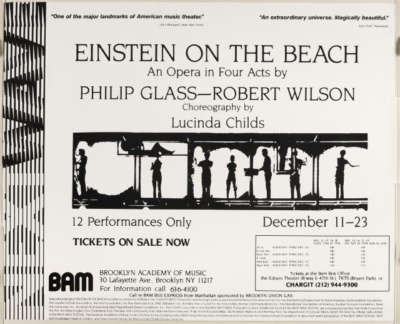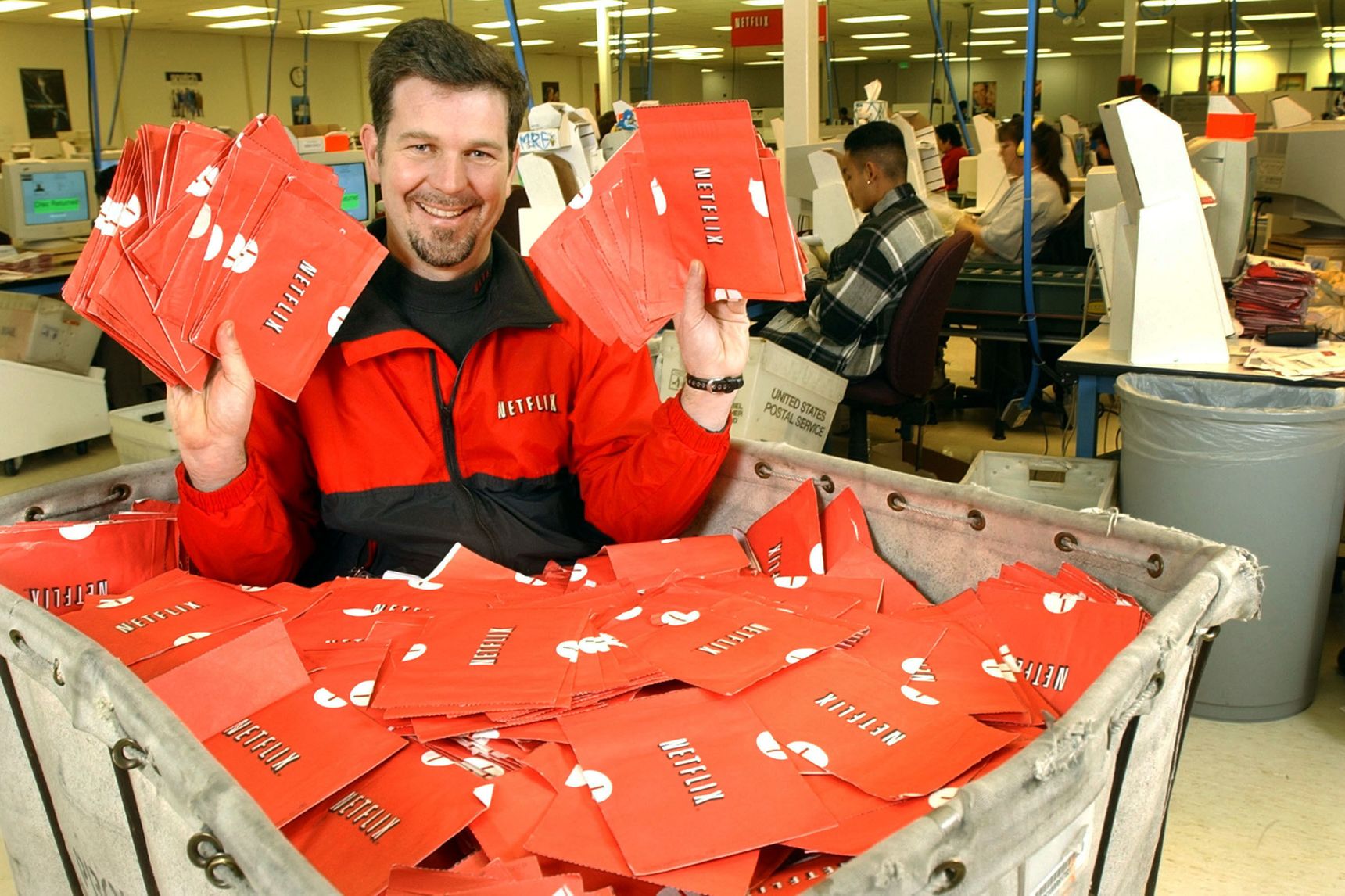THIS WINTER’S REVIVAL of Einstein on the Beach, Robert Wilson and Philip Glass’s epic meditation on the life and meaning of Albert Einstein, raised a number of interesting questions. It had been eight years since the work’s brief and controversial premiere at the New York Metropolitan Opera, and so the most obvious question was how the new presentation at the Brooklyn Academy of Music would compare. Then there was the issue of whether the current audience, having had more exposure to Glass’s hypnotic, incantatory music (if not to Wilson’s equally hypnotic and incantatory theater), would be better prepared for such an unconventional operatic experience. And finally there was the question of how the work would stand up to the passage of time. This last was the one that mattered most; Einstein is very much a product of the Minimalist esthetic of the 1960s and 1970s, so its staying power is bound up in the larger issue of whether minimalism still has anything to say to us in this era of neo-expressionist fervor.

EINSTEIN ON THE BEACH, An Opera in Four Acts. Robert Wilson, Philip Glass, Lucinda Childs. Next Wave Festival, Brooklyn Academy of Music, December 11–23, 1984.
EINSTEIN ON THE BEACH. Philip Glass / Robert Wilson / The Philip Glass Ensemble. CBS Masterworks.
ROBERT WILSON: The Theater of Images, by Robert Wilson. Harper & Row.
The idea of minimalism, as exemplified by Wilson’s theater and Glass’s music, is to use a deliberate paring down of means to achieve a resonant and transcendent end. But this is austere and demanding stuff, and so it’s not surprising that it should provoke a reaction—particularly in America, where the patience necessary to appreciate such works has never been much valued. The current trend toward expressionism, exemplified by the angry histrionics of musicians like Glenn Branca and the paintings of Georg Baselitz and Julian Schnabel, is much more attuned to a public that is active, assertive and eager to get on with it.
By Wilson’s standards, of course, Einstein is brisk: only four and a half hours without intermission, nothing like his The Life and Times of Joseph Stalin, which ran for twelve hours at the Brooklyn Academy in 1973, or his KA MOUNTAIN AND GUARDenia TERRACE, which ran nonstop for seven days and seven nights on an Iranian mountainside. Members of the audience are encouraged to wander in and out of the theater, and the resulting sense of freedom makes the strangeness of it all much easier to handle. And it is strange—like the rest of Wilson’s work, it’s a radical restatement of what theater ought to be and how we ought to respond to it. Instead of characterization and plot, what we have is a series of tableaux vivants which combine dance, music, sculpture and theater in an entrancing and at times profound contemplation of Einstein and much else that popped into Wilson’s head. And what we make of all this depends to an unusual degree on what we bring to it.
Before and After Punk |
A mild-mannered music writer goes to this dive bar on the Bowery. . . |
Why Elvis?The King was just a sweet mama’s boy whose vague dreams of stardom took him places he’d never dreamed of.
|
Minimal and MysticalWhat does “Einstein on the Beach” have to say to us in this post-Minimal era?
|
Laurie Anderson, Multimedia Techno-WaifA spiky-haired extra-terrestrial stumbles forward into the future.
|
A Rotten Success StoryPublic Image Ltd.: Are they committing rock’n’roll suicide, or are they simply boring?
|
Dee Dee Ramone Didn’t Wanna Be a Pinhead No MoreSo the New York rocker who practically invented punk kicked heroin, bought a dinette set, and married Vera, who was, you know . . . normal.
|
Discophobia!Rock & roll fights back.
|
Peter Townshend Gets Old Before He DiesThe leader of the Who has been questioning his role in the youth cult for most of this decade.
|
Elvis Costello Wins Friends and Influences PeopleLast Friday afternoon, the avenger had some explaining to do.
|
Danny Fields Is a Number-One Fan“When I first saw the Ramones I went up to them after the set and—‘You guys are great! You guys are great!’ That’s all I could say.”
|
Four Conversations with Brian EnoHe can look into an interviewer’s face and measure the determination to report something weird.
|
People who come looking for drama and narrative will inevitably find this sort of thing unnerving. But there was no mass exodus this time, as there had been eight years ago at the Met. Einstein was, after all, the climax of BAM’s eleven-week Next Wave Festival, America’s leading showcase for the avant-garde, and what was revolutionary in 1976 seems much less so today. Laurie Anderson, Steve Reich, and Glass and Wilson themselves have made non-narrative performance an accepted, even popular form among sophisticated audiences, while revivals of works such as Oskar Schlemmer’s Bauhaus dances have helped give it historical perspective.
Einstein opens with the first of five “knee plays” (joints connecting the major scenes), in which choreographer Lucinda Childs and longtime Wilson associate Sheryl Sutton sit in a corner of the stage reciting a nonsense story written by a brain-damaged child, while a chorus sings numbers and solfège syllables. Act I, scene 1 contains the first of three train images: a small child stands on a high scaffold holding a plastic cube while a steam locomotive moves across the stage in profile; a woman marches back and forth across the stage; a man standing with his back to the audience writes equations on an invisible blackboard; and a thin shaft of bright white light descends across a backdrop so black it threatens to suck the light out of the theater. (Einstein liked trains as a child.)
Act I, scene 2 is the famous trial scene. Childs appears as a witness, and the little boy and an aged black man sit behind the bench as judges, facing a large bed which occupies center stage. (Is science on trial here? Or sex?) After another knee play, Act II begins with a free-form sequence in which dancers swirl across a field; a spaceship hovers in the distance, and the musical ensemble and chorus send up a shriek that suggests irresistible force. (Are these the forces of nature that science enables us to harness?)
These three images—train, trial and field with spaceship—reappear throughout the opera, each time in a new guise: the train Einstein watches as a boy becomes the train he rides on his honeymoon and then the building that serves as his laboratory; the trial and the bed come back, accompanied by a jail cell, and then the bed comes back alone, rising mysteriously into the air; the field returns with the spaceship closer to us, and finally, in the last scene, we are inside the spaceship. A bizarre array of characters man instruments in a grid that looks like the set of Hollywood Squares while the little boy rides up and down in an elevator, a woman writhes helplessly in another elevator that moves horizontally and has a clock inside, a man onstage looks out at the audience through a telescope, and another man—Wilson himself—waves a flashlight through the air as though signaling a plane to come in for a landing. Meanwhile, on and off throughout the performance, a white-haired fellow who looks a lot like Einstein sits on a high stool in the orchestra pit, playing the violin. (Einstein played the violin to relax.)
Light and motion receive extraordinary treatment here. Light assumes an almost corporeal presence, an eerie physicality which raises it to the level of mystical force. Wilson treats it as sculpture, slicing it up, moving it around, using it to open chasms in the dense blackness of his backdrops. Motion becomes a way of playing with time—speeding it up or slowing it down with highly stylized movements that work with the tempos of Glass’s music to create a hypnotic effect which is periodically shattered and then created anew.
Wilson’s interest in the possibilities of movement came almost as early as his involvement in theater. To overcome a severe childhood stutter, he went to a ballet teacher who showed him how to use slow motion to control his body and then his speech. As a teenager, he taught special exercises to brain-damaged children, and in the 1960s, after coming to New York City from his hometown of Waco, Texas, he supported himself by leading body-awareness classes and working with disturbed children. His techniques enabled him to communicate with old people who hadn’t spoken in months, and he once devised a kind of dance for iron-lung patients by putting strings in their teeth which enabled them to control a construction on the ceiling. The idea behind his therapy was to slow people down to the point where they became fully aware of what they were doing. In Einstein and in his other work, he applies that idea to the theater, slowing it down so that every gesture, every image seems laden with meaning. He forces us to question our everyday perceptions—which is, of course, what Einstein did, and why this opera makes sense at a level beyond literal representation.
Glass’s music is as precise and mathematical as Bach’s, and yet it is as expressive of Einstein’s age as Bach’s is of Newton’s. But what can only be suggested on record is the deep sense of mysticism that emerges in performance.

 March 16, 1985
March 16, 1985




